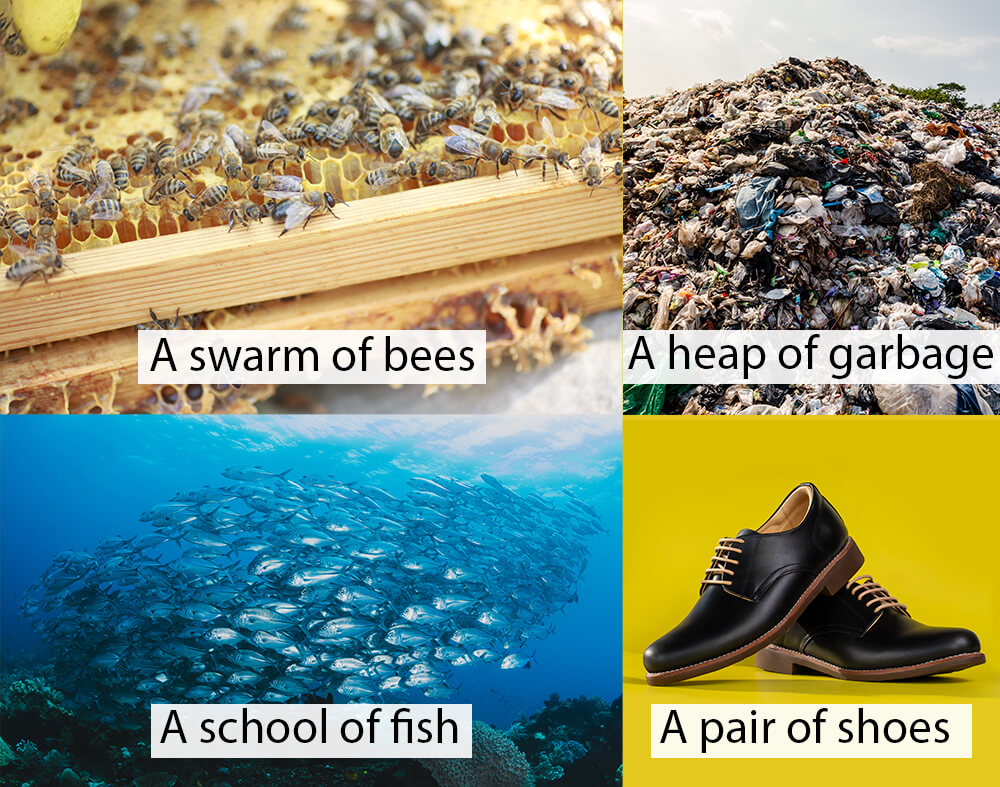Collective Nouns
- Collective nouns describe groups of people, animals, or things, like 'bunch' or 'fleet'.
- To talk about multiple groups, use the structure: number + collective noun + 'of' + noun.
- Examples include phrases like 'a swarm of bees' or 'three flocks of birds'.
Collective nouns are used to refer to groups of similar objects or creatures, acting as a single unit. This lesson focuses on the structure used to denote one or several groups of entities, enhancing your ability to describe and quantify groups in English.
Using Collective Nouns By Themselves
Collective nouns can represent a group of individuals, animals, or things as a single entity. While these nouns describe more than one individual, they often take a singular verb when we consider the group as a single unit.
Here are some common collective nouns:
- Family
- Team
- Class
- Bunch
- Group
Examples:
-
My family lives in California.
The collective noun "family" is treated as a single unit, using a singular verb ("lives").
-
The team is playing tonight.
Here, "team" refers to a group of players acting as one unit, so we use "is" not "are".
-
A bunch of grapes is on the table.
Although "bunch" represents multiple grapes, it is considered a single group, thus "is".
Using a Collective Noun with a Plural Noun
You can also use a collective noun along with a plural noun.
Number + Collective Noun + 'of' + Plural Noun
This structure helps clarify that you are talking about specific groups of items or beings. Here are some examples of commonly used collective nouns:
- Couple (for pairs)
- Heap (for piles of objects, often unordered)
- Fleet (for groups of vehicles, typically ships or taxis)
- Swarm (for large groups of insects)

Examples:
-
A couple of pencils are on the desk.
The structure 'a couple of' indicates a small group of pencils.
-
A heap of garbage lies in the corner.
Here, 'a heap of' refers to an unordered pile of garbage.
-
A fleet of taxis was waiting outside the hotel.
The phrase 'a fleet of' is used for a group of taxis.
-
A swarm of bees is flying in the garden.
The term 'a swarm of' typically describes a large, moving group of bees.
Using Numbers with Collective Nouns
When you want to talk about multiple groups, you add a number at the beginning of our standard structure. This is useful when describing more than one group of entities.
Examples:
-
Three flocks of birds flew over the lake.
The number 'three' indicates multiple groups of birds, each group being a 'flock'.
-
I bought three pairs of shoes at the mall.
Using 'three' here specifies that there are three separate pairs of shoes.

Understanding how to structure phrases with collective nouns will help you communicate more clearly about groups of objects or creatures in English, whether you're talking about a single group or multiple groups.
Pratiquez ce sujet avec le AI English Tutor
AI English Tutor vous apprendra la grammaire et la pratiquera avec vous sous forme de conversation. De plus, plus de 100 questions pratiques sur ce sujet pour consolider votre compréhension.
Essayez ALULA gratuitement sur votre téléphone ou votre tablette








Avez-vous des questions sur cette leçon ? Posez-les dans la section des commentaires, ci-dessous.